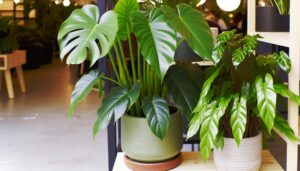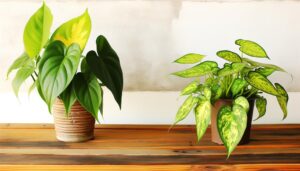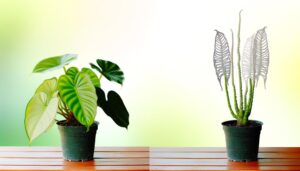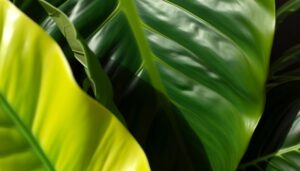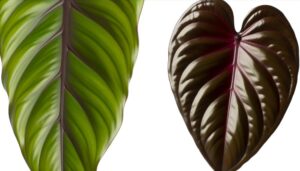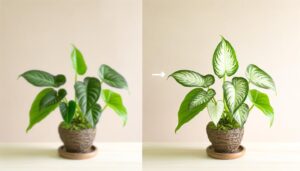Philodendron Hederaceum Vs Pothos: A Quick Comparison
Philodendron hederaceum and Pothos, though similar, have distinct features. Philodendron hederaceum exhibits heart-shaped, matte leaves with a deep green hue, unlike Pothos’ variegated, elliptical leaves which are thicker and waxy.
Philodendron hederaceum, a hemiepiphyte, climbs using aerial roots, while Pothos, an epiphyte, uses adhesive rootlets. Philodendron hederaceum thrives in indirect light and moderate humidity, while Pothos adapts to varied light and broader humidity ranges.
Both plants require well-draining soil but differ in pH preferences and temperature tolerance. Recognizing these differences aids in ideal plant care and growth.
A deeper look into their habitats and care needs reveals more distinctions.
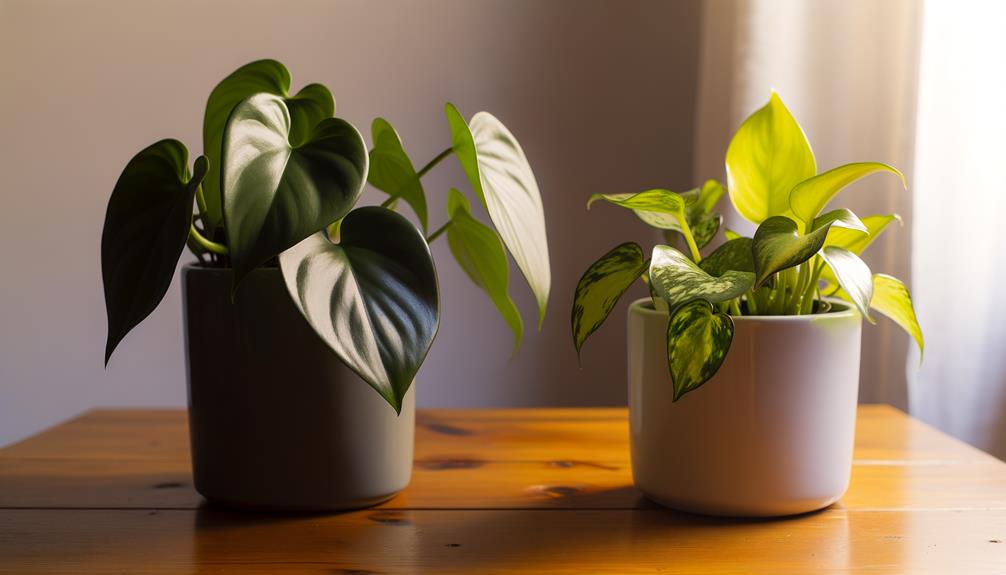
Key Takeaways
- Philodendron hederaceum has heart-shaped, matte, deep green leaves, while Pothos leaves are variegated, elliptical, and waxy.
- Philodendron hederaceum climbs trees using aerial roots, whereas Pothos uses adhesive rootlets for clinging.
- Philodendron hederaceum prefers indirect light and moderate humidity, while Pothos tolerates a broader range of light and humidity conditions.
- Both plants require well-draining soil, but Philodendron hederaceum prefers slightly acidic pH, while Pothos thrives in nutrient-rich soil.
- Root rot, pest infestations, and nutrient deficiencies are common problems for both, needing timely intervention to maintain health.
Philodendron Hederaceum vs. Pothos: A Detailed Comparison
| Feature | Philodendron Hederaceum | Pothos (Epipremnum Aureum) |
|---|---|---|
| Leaf Texture | Smooth, thin, and heart-shaped | Thicker, waxy, heart-shaped or oval leaves |
| Leaf Color | Bright to dark green (some varieties have bronze or reddish tones) | Green, yellow, or variegated with white, yellow, or cream streaks |
| Growth Habit | Vining or trailing | Vining or trailing |
| Light Requirements | Low to medium indirect light | Tolerates low light, prefers bright indirect light |
| Watering Needs | Moderate, let soil dry out slightly between watering | Drought-tolerant, prefers soil to dry out between waterings |
| Size | Can grow up to 10-20 feet long | Can grow up to 10 feet indoors, longer outdoors |
| Growth Speed | Generally slower-growing | Fast-growing, especially in optimal light conditions |
| Native Habitat | Tropical regions of Central and South America | Native to Southeast Asia and the Pacific Islands |
| Distinct Feature | Thin, delicate stems and leaves with heart-shaped foliage | Thicker, more resilient stems and glossy, variegated leaves |
| Toxicity | Toxic to pets if ingested | Toxic to pets if ingested |
Visual Differences
When comparing Philodendron hederaceum and Pothos, one of the most striking visual differences lies in the morphology of their leaves. Philodendron hederaceum features heart-shaped leaves with a matte texture and pronounced veining, typically exhibiting a more uniform, deep green color.
In contrast, Pothos displays thicker, waxier leaves that often display variegation, presenting a mix of green with yellow or white patterns. The leaf shape of Pothos is more elliptical and less pointed at the apex compared to Philodendron hederaceum. Additionally, Pothos leaves are generally more substantial and robust in structure.
These morphological distinctions provide clear indicators for differentiation and reflect adaptations to their respective natural environments, influencing their aesthetic and functional roles in horticulture.
Growth Habits
Philodendron hederaceum and Pothos exhibit distinct growth habits that are reflective of their unique ecological adaptations and morphological characteristics.
Philodendron hederaceum, a hemiepiphyte, often starts life on the forest floor and ascends trees, displaying a scandent growth pattern. Its aerial roots enable it to attach to surfaces, facilitating vertical growth.
Pothos, conversely, is a robust epiphyte that thrives in a variety of light conditions. It exhibits a more aggressive climbing habit, utilizing adhesive rootlets to cling to substrates.
Both species possess indeterminate growth, but Pothos manifests faster stem elongation and denser foliar arrangement.
These differential growth habits underscore their evolutionary strategies for resource acquisition and habitat colonization, reflecting adaptive divergence in their natural environments.
Care Requirements
Effective care for Philodendron hederaceum and Pothos requires an understanding of their distinct environmental preferences and physiological needs.
Philodendron hederaceum thrives in indirect light, preferring moderate humidity levels and well-draining soil with a slightly acidic pH. Watering should be consistent but moderate, ensuring the soil remains moist but not waterlogged.
Conversely, Pothos exhibits higher tolerance to varying light conditions, from low to bright indirect light, and can adapt to a broader range of humidity levels. Its soil should be nutrient-rich and well-draining. It is vital to allow the top layer of soil to dry out between waterings to prevent root rot.
Both species benefit from periodic fertilization during the growing season to support best growth and liveliness.
Common Problems
Common issues faced with Philodendron hederaceum and Pothos frequently involve problems such as root rot, pest infestations, and nutrient deficiencies. Each demands specific diagnostic and remedial actions.
Root rot, mainly caused by excessive watering, appears as blackened, mushy roots and yellowing leaves.
Pest infestations, notably spider mites and mealybugs, show as webbing or white cotton-like clusters on leaves, requiring immediate treatment with insecticidal soap or neem oil.
Nutrient deficiencies, often due to insufficient fertilization, lead to chlorosis or stunted growth. These conditions can be corrected by adjusting the nutrient regime to include balanced fertilizers.
Accurate identification of symptoms and timely intervention are essential in mitigating these common issues to maintain the health and vigor of these popular houseplants.
Ideal Environments
Understanding the best conditions for Philodendron hederaceum and Pothos is paramount to preventing many of the common problems previously discussed, such as root rot and nutrient deficiencies.
Philodendron hederaceum thrives in indirect, bright light and prefers temperatures between 65-80°F (18-27°C). It requires well-draining soil with a balanced pH. Humidity levels of 60-80% are ideal.
Conversely, Pothos, though similarly resilient, tolerates lower light conditions and can adapt to a wider temperature range, from 55-85°F (13-29°C). It also favors well-draining soil but is less stringent about humidity, thriving even in lower levels around 40-60%.
Both species benefit from periodic fertilization but require careful watering to avoid waterlogging, a critical factor in their overall health.
Conclusion
In comparing Philodendron hederaceum and Pothos, key distinctions emerge in visual characteristics, growth habits, and care requirements. Despite common misconceptions, these species exhibit unique attributes necessitating specific environmental conditions.
Philodendron hederaceum demands higher humidity and indirect light, whereas Pothos proves more resilient under varying conditions. Addressing common problems, such as pest infestations, further underscores their differences.
Ultimately, an informed understanding of each plant’s needs facilitates best growth, dismissing the notion that these species are interchangeable in horticultural practice.

